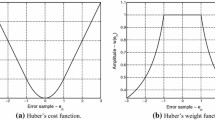Abstract
This paper presents a novel approach to the modelling and control of a specific class of nonlinear systems whose parameters are unknown nonlinear functions of the measurable operating points. An associative memory network is used to identify each nonlinear function, whose inputs are the measurable operating points and output being the estimated value of the parameter. Two different cases are considered; the first being those systems where the networks can exactly model the nonlinear functions, whereas the second case considers those systems which can only approximate the nonlinear functions toa known accuracy. The first type of system is referred to as a matching system and the second is called a mismatching system. During the modelling phase, the weights for each network are trained in parallel using the normalised back-propagation algorithm for matching system, and the modified recursive least squares algorithm for mismatching systems. It has been shown that these algorithms together withGoodwin's technical lemma lead to a stable d-step-ahead control scheme for matching systems and a pole assignment control strategy for mismatching systems.
Similar content being viewed by others
References
Albus, J. S., “A new approach to manipulator: the cerebellar model articulation controller (CMAC),”Trans. ASME J. Dyn. Sys. Meas. Cont., vol. 97, pp. 220–227, 1975.
An, P. C., Brown, M., Harris, C. J., Lawrence, A. J., and Moore, C. G., “Comparative aspects of associative memory networks for modelling,”Proc. European Control Conference, Groningen, The Netherlands, vol. 2, pp. 454–459, 1993.
Brown, M., Harris, C. J.,Neurofuzzy Adaptive Modelling and Control, Prentice Hall: London, 1994.
Chen, S., Cowan, C. F. N., and Grant, P. M., “Orthogonal least squares learning algorithm for radial basis function networks,”IEEE Trans. Neural Networks, vol. 2, no. 2, pp. 302–309, 1991.
Franklin, G. F., Powell, J. D., and Emami-Naeini, Feedback Control of Dynamic Systems, Addison-Wesley Publishing Company, 1988.
Girosi, F., and Poggio, T., “Networks and the best approximation property,”Biol. Cybern., vol. 63, pp. 169–176, 1990.
Goodwin, G. C., and Sin, K. S.,Adaptive Filtering, Prediction and Control, Prentice-Hall, 1984.
Hagglund, T., “New estimation techniques for adaptive control,”Ph.D dissertation, Linkoping University, Sweden, 1984.
Miller, W. T., “Real-time application of neural networks for sensor based control of robots with vision,”IEEE Trans. on Sys. Man and Cyb., vol. 19, pp. 825–831, 1989.
Millnert, M., “Identification and control of systems subject to abrupt changes”Ph.D dissertation, Linkoping Univ., Sweden, 1982.
Multivariable Gas Turbine Controls: SERC/Lucas Aerospace/DRA Collaborative research project: Universities of Leicester, Strathclyde and Southampton.
Narendra, K. S., and Parthasarathy, K., “Identification and control of dynamic systems using neural networks,”IEEE Trans. Neural Networks, vol. 1, pp. 4–27, 1990.
Polycarpou, M. M., and Ioannou, P. A., “Learning and convergence analysis of neural-type structured networks,”IEEE Trans. Neural Networks, vol. 3, pp. 39–50, 1992.
Rumelhart, D. E., Hinton, G. E., and Williams, R. J., “Learning internal representations by error propagation,” inParallel Distributed Processing, vol. 1, Eds. D. E. Rumelhart and J. L. McClelland, Cambridge MA: MIT Press,1986.
Sanner, R. M., and Slotine, J. E., “Gaussian networks for direct adaptive control,”IEEE Trans. Neural Networks, vol. 3, no. 6, pp. 837–863, 1992.
Sarpturk, S., Istefanopulos, Y., and Kaynak, O., “On the stability of discrete-time sliding mode control systems,”IEEE Trans. Auto. Contr., vol. 32, pp. 930–932, 1987.
Slotine, J. E., “Sliding controller design for nonlinear systems,”Int. J. Contr., vol. 40, p. 421, 1984.
Wang, H., Liu, Y. Q., and You, D. H., “dApplication of a nonlinear self-tuning controller for regulating the speed of a hydraulic turbine,” Trans. ASME. J Dyn. Sys. Meas. and Control, vol. 113, pp. 541–544, 1991.
Widrow, B., and Lehr, M. A., “30 years of adaptive neural networks: perceptron, madaline and backpropagation,”Proc. IEEE, vol. 78, no. 9, pp. 1415–1441, 1990.
Wu, Q. H., and Hogg, B. W., “Adaptive controller for a turbogenerator system,”IEEE Part D, vol. 135, pp. 274–279, 1988.
Xie, X., and Evans, R., “Discrete-time adaptive control for deterministic time-varying systems,”Automatica, vol. 20, pp. 309–319, 1984.
Author information
Authors and Affiliations
Rights and permissions
About this article
Cite this article
Wang, H., Brown, M. & Harris, C.J. Modelling and control of nonlinear, operating point dependent systems via associative memory networks. Dynamics and Control 6, 199–218 (1996). https://doi.org/10.1007/BF02169537
Received:
Revised:
Issue Date:
DOI: https://doi.org/10.1007/BF02169537




